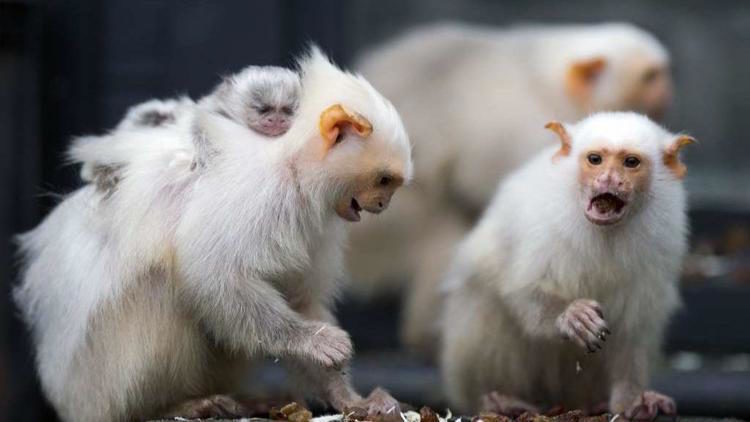
Marmosets engage in rigorously polite patterns of communication and do not talk over or interrupt each other. Though territorial, they are so inquisitive that they will watch videos of marmosets they do not know and learn from them.
Marmosets' social organization and child-rearing practices could have been the model for the phrase, "it takes a village." A dominant male and female breed, and their babies are meticulously looked after by extended family members who then aren't free to breed themselves.
A new study further burnishes the marmoset's reputation for admirable community values. Researchers report that these caregivers share their food more generously with little ones in private than when they're surrounded by the watchful eyes of other community members.
Such seemingly selfless behavior makes the common marmoset a particular puzzle for researchers keen to explain the already-perplexing phenomenon of altruism in humans and a few other higher-order primates.
After all, in stark evolutionary terms, kindness, generosity and self-sacrifice make no sense. When an individual's survival and the propagation of his genes arguably depend on his hoarding every advantage for himself, why on earth would he forfeit anything to benefit a fellow member of his species?
For marmosets, it's hard enough to explain the willingness of some family members to delay or forgo breeding to help out with a relative's offspring. But to share food with those babies when no one's looking? That just defies all expectations.
In complex societies where individuals band together for mutual protection, researchers have come up with a few widely embraced explanations for altruistic behavior.
Boosting the prospects of a relative's child - kinship selection - does help propagate at least a few of an individual's genes, and thus seems a good general explanation for self-sacrificing behavior. But specific acts, like sharing a delicious cricket with a begging baby marmoset, seem to need more specific explanation.
One possibility is that an individual practices generosity as a means of enhancing his status among peers. By demonstrating that he is so well-endowed with material goods that he can give some away, this do-gooder enhances his prestige within the group. That, in turn, may appeal to prospective mates.
The other explanation for charitable behavior posits that kindnesses extended to others are simply the dues of group membership, which offers some future promise of a chance to mate. Failure to share would result in expulsion from the group and a loss of prospective partners. Scientists call this the "pay to stay" model.
Importantly, for both of these models to work, acts of kindness must have an audience. That suggests you would see more sharing in group settings - away from judging eyes, a caregiver might be more inclined to keep food for him or herself.
And yet, in 2,581 trials conducted with 31 adult and 14 baby marmosets, the opposite appeared to be true.
Anthropologists from the University of Zurich carefully documented how often, in groups and in conditions that found caregiver and baby separated from the crowd, an adult would share his or her cricket.
When alone with a baby begging for a taste, adult marmosets shared their cricket 85% of the time. When in a group, caregivers offered up their cricket 67% of the time.
"Our results show that helping in common marmosets is not driven by reputation management or punishment avoidance," the study authors reported. "Rather, it is driven by an intrinsic motivation to help that is more strongly expressed when individuals are alone with offspring."
What motivated these acts of kindness? The authors offered a human parallel as a possibility.
"The marmoset pattern of results calls to mind the so-called diffusion of responsibility effect, which is well established in humans," the authors write. "People are less likely to help in the presence of a larger number of bystanders, but feel more responsible when alone with a needy individual."
Whether that pattern fits will require more research, not only in marmosets but with chimpanzees and capuchin monkeys, whose breeding patterns are far less cooperative.
The study was published this week in the journal Biology Letters.
Melissa Healy is a health and science reporter with the Los Angeles Times writing from the Washington, D.C., area. She covers prescription drugs, obesity, nutrition and exercise, and neuroscience, mental health and human behavior. She's been at The Times for more than 30 years, and has covered national security, environment, domestic social policy, Congress and the White House. As a baby boomer, she keenly follows trends in midlife weight gain, memory loss and the health benefits of red wine.



Reader Comments